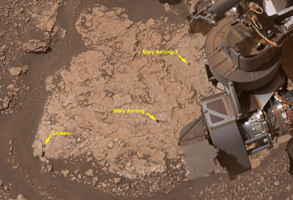
|
Curiosity’s Selfie at the Mary Anning location on Mars
- Click the image above for a larger view
- Full-Res JPEG (9849 x 11724) (11.0 MB)
- Full-Res TIFF (9849 x 11724) (281.9 MB)
Caption:

Figure 1
NASA's Curiosity Mars rover took this selfie at a location nicknamed "Mary Anning" after a 19th century English paleontologist. Curiosity snagged three samples of drilled rock at this site on its way out of the Glen Torridon region, which scientists believe was a site where ancient conditions would have been favorable to supporting life, if it ever was present.
Curiosity took the selfie using a camera called the Mars Hand Lens Imager located on the end of its robotic arm (videos explaining how Curiosity's selfies are taken can be found here ). A close-up detail from within the selfie shows the three holes that a rock drill, also found on the end of Curiosity's arm, added to the surface. The three drill holes are named "Mary Anning," "Mary Anning 3" and "Groken," the last name coming from a site of geological interest in the Scottish countryside.
Background Info:
Curiosity was built by NASA's Jet Propulsion Laboratory in Southern California. Caltech in Pasadena, California, manages JPL for NASA. JPL manages Curiosity's mission for NASA's Science Mission Directorate in Washington. MAHLI was built by Malin Space Science Systems in San Diego.
For more about Curiosity:
Cataloging Keywords:
| Name | Value | Additional Values |
|---|---|---|
| Target | Mars | |
| System | ||
| Target Type | Planet | |
| Mission | Mars Science Laboratory (MSL) | |
| Instrument Host | Curiosity Rover | |
| Host Type | Rover | |
| Instrument | Mars Hand Lens Imager (MAHLI) | |
| Detector | ||
| Extra Keywords | Color | |
| Acquisition Date | ||
| Release Date | 2020-11-12 | |
| Date in Caption | ||
| Image Credit | NASA/JPL-Caltech/MSSS | |
| Source | photojournal.jpl.nasa.gov/catalog/PIA24173 | |
| Identifier | PIA24173 | |
